小学英语教案模板 全英文
小学英语教案模板(5篇)
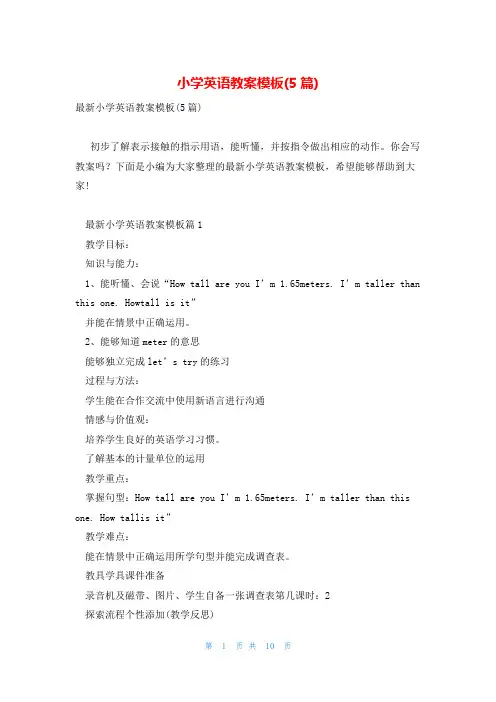
小学英语教案模板(5篇)最新小学英语教案模板(5篇)初步了解表示接触的指示用语,能听懂,并按指令做出相应的动作。
你会写教案吗?下面是小编为大家整理的最新小学英语教案模板,希望能够帮助到大家!最新小学英语教案模板篇1教学目标:知识与能力:1、能听懂、会说“How tall are you I’m 1.65meters. I’m taller than this one. Howtall is it”并能在情景中正确运用。
2、能够知道meter的意思能够独立完成let’s try的练习过程与方法:学生能在合作交流中使用新语言进行沟通情感与价值观:培养学生良好的英语学习习惯。
了解基本的计量单位的运用教学重点:掌握句型:How tall are you I’m 1.65meters. I’m taller than this one. How tallis it”教学难点:能在情景中正确运用所学句型并能完成调查表。
教具学具课件准备录音机及磁带、图片、学生自备一张调查表第几课时:2探索流程个性添加(教学反思)1. preparation(预习)1.日常口语练习。
2.复习单词:taller、 longer、 older、 younger 、shorter2. presentation(新课呈现)(1)Let’s try教师播放录音,学生独立完成练习并核对答案(2)Let’s talka.生阅读对话,并解释大意b.教师范读,学生跟读c.分组读,个别读回答问题d.播放录音,学到再次跟读3.practice(练习)(1).T: How tall are you I’m 1.65metres.引导学生回答,并多加练习。
(2).做完后教师出示图片问How tall are you请学生轮流回答。
(3).把图片出示给学生,让他们加强练习。
同桌或小组之间互相练习。
(4).学生两人分角色朗读课文对话。
4.homework(家庭拓展)(1).做本单元A Let’s talk部分的活动手册配套练习。
全英版小学英语教案【三篇】
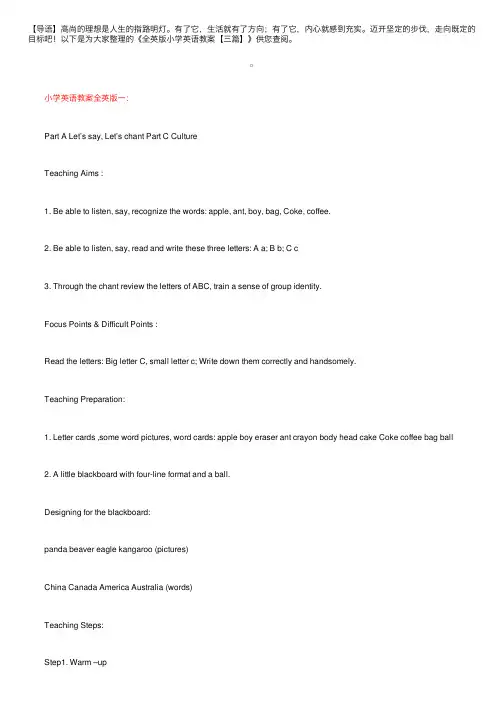
【导语】⾼尚的理想是⼈⽣的指路明灯。
有了它,⽣活就有了⽅向;有了它,内⼼就感到充实。
迈开坚定的步伐,⾛向既定的⽬标吧!以下是为⼤家整理的《全英版⼩学英语教案【三篇】》供您查阅。
⼩学英语教案全英版⼀: Part A Let’s say, Let’s chant Part C Culture Teaching Aims : 1. Be able to listen, say, recognize the words: apple, ant, boy, bag, Coke, coffee. 2. Be able to listen, say, read and write these three letters: A a; B b; C c 3. Through the chant review the letters of ABC, train a sense of group identity. Focus Points & Difficult Points : Read the letters: Big letter C, small letter c; Write down them correctly and handsomely. Teaching Preparation: 1. Letter cards ,some word pictures, word cards: apple boy eraser ant crayon body head cake Coke coffee bag ball 2. A little blackboard with four-line format and a ball. Designing for the blackboard: panda beaver eagle kangaroo (pictures) China Canada America Australia (words) Teaching Steps: Step1. Warm –up 1. Sing a song. 2. Free talk T: Hello. I’m Wendy. I’m from Hangzhou. S1: Hello! I’m ... I’m from Hangzhou,too. T: Nice to meet you. S: Nice to meet you, too. T: Let’s play. Ok? S: Great! T: Watch out! (T throws the ball.) S: Oh, no. Make a similar dialogue with your partner. Step2.Presentation. 1. 1)T : Today, we will learn letters. Do you know letters? Just as A,B,C…… They are letters. What’s the meaning of letters? S: 字母。
小学英语优秀教案(精选5篇)
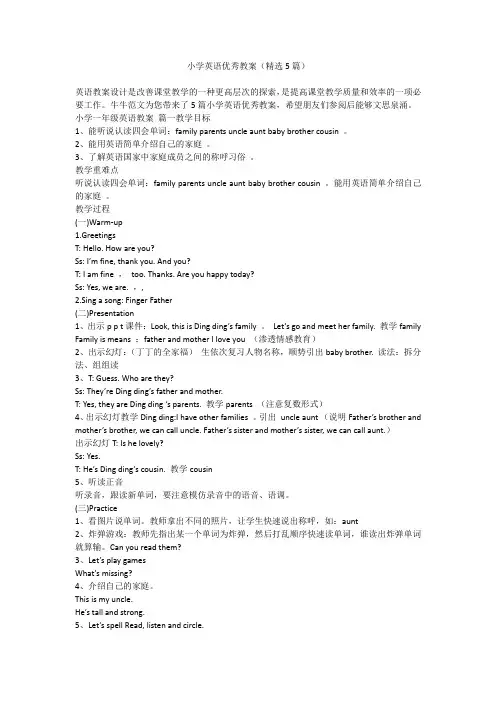
小学英语优秀教案(精选5篇)英语教案设计是改善课堂教学的一种更高层次的探索,是提高课堂教学质量和效率的一项必要工作。
牛牛范文为您带来了5篇小学英语优秀教案,希望朋友们参阅后能够文思泉涌。
小学一年级英语教案篇一教学目标1、能听说认读四会单词:family parents uncle aunt baby brother cousin 。
2、能用英语简单介绍自己的家庭。
3、了解英语国家中家庭成员之间的称呼习俗。
教学重难点听说认读四会单词:family parents uncle aunt baby brother cousin 。
能用英语简单介绍自己的家庭。
教学过程(一)Warm-up1.GreetingsT: Hello. How are you?Ss: I’m fine, thank you. And you?T: I am fine ,too. Thanks. Are you happy today?Ss: Yes, we are. ,,2.Sing a song: Finger Father(二)Presentation1、出示p p t课件:Look, this is Ding ding’s family 。
Let’s go and meet her family. 教学family Family is means :father and mother I love you (渗透情感教育)2、出示幻灯:(丁丁的全家福)生依次复习人物名称,顺势引出baby brother. 读法:拆分法、组组读3、T: Guess. Who are they?Ss: They’re Ding ding’s father and mother.T: Yes, they are Ding ding ‘s parents. 教学parents (注意复数形式)4、出示幻灯教学Ding ding:I have other families 。
小学英语教案20篇英文版
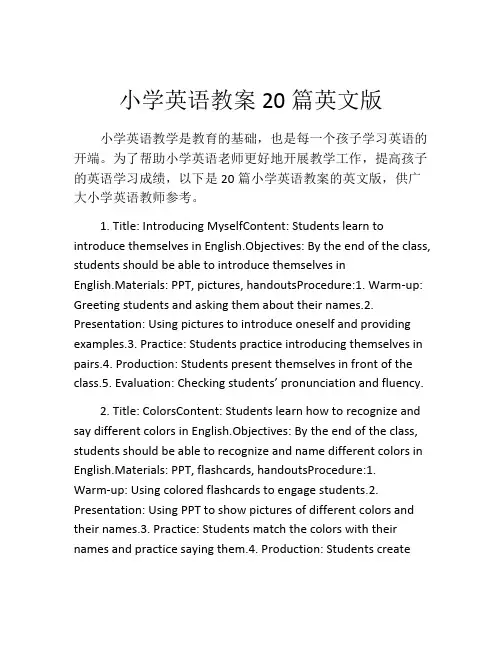
小学英语教案20篇英文版小学英语教学是教育的基础,也是每一个孩子学习英语的开端。
为了帮助小学英语老师更好地开展教学工作,提高孩子的英语学习成绩,以下是20篇小学英语教案的英文版,供广大小学英语教师参考。
1. Title: Introducing MyselfContent: Students learn to introduce themselves in English.Objectives: By the end of the class, students should be able to introduce themselves inEnglish.Materials: PPT, pictures, handoutsProcedure:1. Warm-up: Greeting students and asking them about their names.2. Presentation: Using pictures to introduce oneself and providing examples.3. Practice: Students practice introducing themselves in pairs.4. Production: Students present themselves in front of the class.5. Evaluation: Checking students’ pronunciation and fluency.2. Title: ColorsContent: Students learn how to recognize and say different colors in English.Objectives: By the end of the class, students should be able to recognize and name different colors in English.Materials: PPT, flashcards, handoutsProcedure:1.Warm-up: Using colored flashcards to engage students.2. Presentation: Using PPT to show pictures of different colors and their names.3. Practice: Students match the colors with their names and practice saying them.4. Production: Students createtheir own pictures and describe them in English.5. Evaluation: Checking students’ ability to recognize and name different colors.3. Title: NumbersContent: Students learn how to recognize and say the numbers from 1 to 20 in English.Objectives: By the end of the class, students should be able to recognize and say the numbers from 1 to 20 in English.Materials: PPT, flashcards, handoutsProcedure:1. Warm-up: Using number flashcards to engage students.2. Presentation: Using PPT to show pictures of the numbers from 1 to 20 and their names.3. Practice: Students match the numbers with their names and practice saying them.4. Production: Students practice counting in English and count the number of objects in the classroom.5. Evaluation: Checking students’ ability to recognize and say the numbers from 1 to 20.4. Title: ShapesContent: Students learn how to recognize and name different shapes in English.Objectives: By the end of the class, students should be able to recognize and name different shapes in English.Materials: PPT, flashcards, handoutsProcedure:1. Warm-up: Using shape flashcards to engage students.2. Presentation: Using PPT to show pictures of different shapes and their names.3. Practice: Students match the shapes with their names and practice saying them.4. Production: Students create their own pictures using different shapes and describe them in English.5. Evaluation: Checki ng students’ ability to recognize and name different shapes.5. Title: FamilyContent: Students learn how to talk about their family members in English.Objectives: By the end of the class, students should be able to talk about their family members in English.Materials: PPT, flashcards, handoutsProcedure:1.Warm-up: Asking students about their family members.2. Presentation: Using PPT to show pictures of different family members and their names.3. Practice: Students practice talking about their family members in pairs.4. Production: Students present their family members in front of the class.5. Evaluation: Checking students’ ability to talk about their family members in English.6. Title: AnimalsContent: Students learn how to recognize and name different animals in English.Objectives: By the end of the class, students should be able to recognize and name different animals in English.Materials: PPT, flashcards, handoutsProcedure:1. Warm-up: Using animal flashcards to engage students.2. Presentation: Using PPT to show pictures of different animals and their names.3. Practice: Students match the animals with their names and practice saying them.4. Production: Students create their own pictures using different animals and describe them in English.5. Evaluation: Chec king students’ ability to recognize and name different animals.7. Title: WeatherContent: Students learn how to recognize and name different types of weather in English.Objectives: By the end of the class, students should be able to recognize and name different types of weather in English.Materials: PPT, flashcards,handoutsProcedure:1. Warm-up: Asking students about the weather outside.2. Presentation: Using PPT to show pictures of different types of weather and their names.3. Practice: Students practice recognizing and naming different types of weather.4. Production: Students describe the weather in a particular place.5. Evaluation: Checking students’ ability to recognize and name different types of weather.8. Title: Food and DrinksContent: Students learn how to recognize and name different types of food and drinks in English.Objectives: By the end of the class, students should be able to recognize and name different types of food and drinks in English.Materials: PPT, flashcards, handoutsProcedure:1.Warm-up: Asking students about their favorite food and drinks.2. Presentation: Using PPT to show pictures of different types of food and drinks and their names.3. Practice: Students practice recognizing and naming different types of food and drinks.4. Production: Students decide on a menu and describe the food and drinks in English.5. Evaluation: Checking students’ ability to recognize and name different types of food and drinks.9. Title: My BodyContent: Students learn how to recognize and name different parts of the body in English.Objectives: By the end of the class, students should be able to recognize and name different parts of the body in English.Materials: PPT, flashcards, handoutsProcedure:1. Warm-up: Asking students about different parts of the body.2. Presentation: Using PPT to show pictures of different parts of the body and their names.3. Practice: Studentspractice recognizing and naming different parts of the body.4. Production: Students draw a person and label the different parts of the body in Eng lish.5. Evaluation: Checking students’ ability to recognize and name different parts of the body.10. Title: JobsContent: Students learn how to recognize and name different types of jobs in English.Objectives: By the end of the class, students should be able to recognize and name different types of jobs in English.Materials: PPT, flashcards, handoutsProcedure:1. Warm-up: Asking students about their dream job.2. Presentation: Using PPT to show pictures of different types of jobs and their names.3. Practice: Students practice recognizing and naming different types of jobs.4. Production: Students choose a job and describe it in English.5. Evaluation: Checking students’ ability to recognize and name different types of jobs.11. Title: Days of the WeekContent: Students learn how to recognize and say the days of the week in English.Objectives: By the end of the class, students should be able to recognize and say the days of the week in English.Materials: PPT, flashcards, handoutsProcedure:1. Warm-up: Asking students about their favorite day of the week.2. Presentation: Using PPT to show pictures of the days of the week and their names.3. Practice: Students practice recognizing and saying the days of the week.4. Production: Students describe their schedule for the week.5. Evaluation: Checking students’ ability to recognize and say the days of the week.12. Title: Months of the YearContent: Students learn how to recognize and say the months of the year in English.Objectives: By the end of the class, students should be able to recognize and say the months of the year in English.Materials: PPT, flashcards, handoutsProcedure:1. Warm-up: Asking students about their favorite month of the year.2. Presentation: Using PPT to show pictures of the months of the year and their names.3. Practice: Students practice recognizing and saying the months of the year.4. Production: Students describe their favorite season and the months that belong to it.5. Evaluation: Checking students’ ability to recognize and say the months of the year.13. Title: TimeContent: Students learn how to tell the time in English.Objectives: By the end of the class, students should be able to tell the time in English.Materials: PPT, flashcards, handoutsProcedure:1. Warm-up: Asking students about their favorite time of the day.2. Presentation: Using PPT to show pictures of the clock and different times.3. Practice: Students practice telling the time in English.4. Production: Students plan their daily schedule and write it in English.5. Evaluation: Checking students’ ability to tell the time in English.14. Title: Weather ForecastContent: Students learn how to give a weather forecast in English.Objectives: By the end of the class, students should be able to give a weather forecast in English.Materials: PPT, flashcards, handoutsProcedure:1.Warm-up: Asking students about the weather outside.2. Presentation: Using PPT to show different weather conditions andvocabulary.3. Practice: Students practice giving a weather forecast in pairs.4. Production: Students give a weather forecast in front of the class.5. Evaluation: Checking students’ ability to give a weather forecast in English.15. Title: SeasonsContent: Students learn how to recognize and name the different seasons in English.Objectives: By the end of the class, students should be able to recognize and name the different seasons in English.Materials: PPT, flashcards, handoutsProcedure:1. Warm-up: Asking students about their favorite season.2. Presentation: Using PPT to show pictures of the different seasons and their names.3. Practice: Students practice recognizing and naming the different seasons.4. Production: Students write a paragraph about their favorite season in English.5. Evaluation: Checking students’ ability to recognize and name the different seasons in English.16. Title: ToysContent: Students learn how to recognize and name different types of toys in English.Objectives: By the end of the class, students should be able to recognize and name different types of toys in English.Materials: PPT, flashcards, handoutsProcedure:1. Warm-up: Asking students about their favorite toy.2. Presentation: Using PPT to show pictures of different types of toys and their names.3. Practice: Students practice recognizing and naming different types of toys.4. Production: Students describe their favorite toy in English.5. Evaluation: Checking students’ ability to recognize and name different types of toys.17. Title: School SuppliesContent: Students learn how to recognize and name different school supplies in English.Objectives: By the end of the class, students should be able to recognize and name different school supplies in English.Materials: PPT, flashcards, handoutsProcedure:1. Warm-up: Asking students about their favorite school supply.2. Presentation: Using PPT to show pictures of different school supplies and their names.3. Practice: Students practice recognizing and naming different school supplies.4. Production: Students describe the contents of their school bag in English.5. Evaluation: Checking students’ ability to recognize and name different school supplies.18. Title: Parts of a HouseContent: Students learn how to recognize and name different parts of a house inEnglish.Objectives: By the end of the class, students should be able to recognize and name different parts of a house in English.Materials: PPT, flashcards, handoutsProcedure:1.Warm-up: Asking students about the different rooms in their house.2. Presentation: Using PPT to show pictures of different parts of a house and their names.3. Practice: Students practice recognizing and naming different parts of a house.4. Production: Students describe their favorite room in their house in English.5. Evaluation: Checking students’ ability to recognize and name different parts of a house.19. Title: HolidaysContent: Students learn how to recognize and name different holidays in English.Objectives: By the end of the class, students should be able to recognize and name differentholidays in English.Materials: PPT, flashcards, handoutsProcedure:1. Warm-up: Asking students about their favorite holiday.2. Presentation: Using PPT to show pictures of different holidays and their names.3. Practice: Students practice recognizing and naming different holidays.4. Production: Students write about their favorite holiday in English.5. Evaluation: Checking students’ ability to recognize and name different holidays in English.20. Title: SportsContent: Students learn how to recognize and name different sports in English.Objectives: By the end of the class, students should be able to recognize and name different sports in English.Materials: PPT, flashcards, handoutsProcedure:1. Warm-up: Asking students about their favorite sport.2. Presentation: Using PPT to show pictures of different sports and their names.3. Practice: Students practice recognizing and naming different sports.4. Production: Students describe their favorite sport in English.5. Evaluation: Checking students’ ability to recognize and name different sports in English.以上是20篇小学英语教案的英文版,它们覆盖了小学英语教学的各个方面。
小学英语教案全英文版(最新)
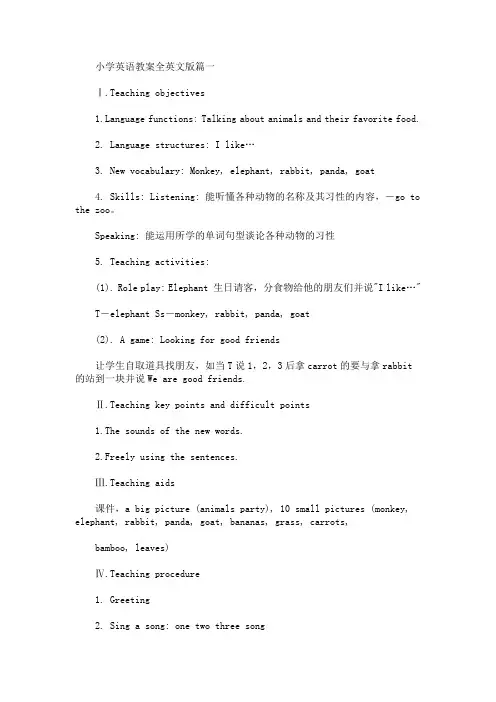
小学英语教案全英文版篇一Ⅰ.Teaching objectivesnguage functions: Talking about animals and their favorite food.2. Language structures: I like…3. New vocabulary: Monkey, elephant, rabbit, panda, goat4. Skills: Listening: 能听懂各种动物的名称及其习性的内容,-go to the zoo。
Speaking: 能运用所学的单词句型谈论各种动物的习性5. Teaching activities:(1). Role play: Elephant 生日请客,分食物给他的朋友们并说"I like…"T-elephant Ss-monkey, rabbit, panda, goat(2). A game: Looking for good friends让学生自取道具找朋友,如当T说1,2,3后拿carrot的要与拿rabbit的站到一块并说We are good friends.Ⅱ.Teaching key points and difficult points1.The sounds of the new words.2.Freely using the sentences.Ⅲ.Teaching aids课件,a big picture (animals party), 10 small pictures (monkey, elephant, rabbit, panda, goat, bananas, grass, carrots,bamboo, leaves)Ⅳ.Teaching procedure1. Greeting2. Sing a song: one two three song3. say goodbye to the 1, 2, 3 and go to the zooT: We are going to the zoo today. Therere many animals at the zoo.T introduces animals by action and sound, show animals pictures and put them on the big picture, and teachtheir names. ( 使用课件Part 1 )4. Review food names and teach " I like…" (使用课件Part 2 )(1). T act as the elephant, tell Ss "today is my birthday, I have food and Ill give them to my friends "( T showsfood pictures and Ss review)(2).role play:T act as the elephant first and teach " I like…", and then find my friends( Ss) to play and practice the sentences.5. CA: T shows pictures, Ss practice the sentences6. PA: Ss use their food to practice the sentences7. A game: Looking for good friends( moral education: We are friends, we should take good care of each other.)(1). 先找S1配合示范: T在B上找到monkey的图片, S1找到bananas的图片, T and Ss say " were good friends", ask Ss to play.(2). 对对碰:Let 10Ss hold 10 pictures, when T say 1, 2, 3 , Ss should find their friends at once.8. Sing a song: two little black birds ( 使用课件Part 3 )9. Sum up (使用课件Part 1 and 2 )小学英语教案全英文版篇二Teaching objectives:1.It looks like ____.2.cloud , sky3.lie.Danny goes to the park, we should clear about its meaning. It’s fun and happy, if you have time you can go out to play after you have finished your words.The nature is clear and vivid, clean air, green trees and leaves, white clouds, beautiful flowers. We can go out share it.Teaching focal points:1.how to use “look like”2.lieTeaching difficulty points:1.how to use “look like”2.lieTeaching aims:A tapeA big picture of the dialogueTeaching steps:Class opening and reviewReview “flowers” “leaves” “grass” with a drill. Choose a drill from “Teaching Techniques”IntroduceDemonstrate “cloud” and “sky” with your poster, or by pointing out the window of your classroom.Draw quick pictures of clouds on the blackboard.Make the clouds look like something. Say phrases such as:Use a puppet to introduce the word “lie” For example, draw quick pictures of a bed and some grass on the blackboard. Make the pu ppet “lie” on these as you say phrases for it such as:I am tired. I want to sleep.Where can I sleep?Here’s a bed. I am going to lie on the bed.Now I am lying on the bed.I don’t want to sleep here!Here’s some grass.Now I am lying on the grass.Now I can see the sky!PracticeDivide the class into small groups. Ask each group to make up a dialogue about lying on the grass and looking at clouds in the sky. Please read about making up dialogues in “Teaching Techniques”Pl ay “Go Fish” or “Memory Card” with the students’ flashcards for the following words: cloud, sky, flowers, leaves, grass, snow, ice, rain, sun and wind.Use the activity bookNumber 2 in the activity book is a listening exercise on the audiotape as follows:Listen, draw the shapes and write the words.a triangleb. linec. circled. squareBlackboard show:Lesson19:Let’s go to the park lie on cloud skyIt looks like _________ .。
小学英语全英教案【通用6篇】

小学英语全英教案【通用6篇】(经典版)编制人:__________________审核人:__________________审批人:__________________编制单位:__________________编制时间:____年____月____日序言下载提示:该文档是本店铺精心编制而成的,希望大家下载后,能够帮助大家解决实际问题。
文档下载后可定制修改,请根据实际需要进行调整和使用,谢谢!并且,本店铺为大家提供各种类型的经典范文,如总结报告、演讲发言、规章制度、员工手册、创业计划、企划方案、心得体会、法律文书、教学资料、其他范文等等,想了解不同范文格式和写法,敬请关注!Download tips: This document is carefully compiled by this editor. I hope that after you download it, it can help you solve practical problems. The document can be customized and modified after downloading, please adjust and use it according to actual needs, thank you!Moreover, our store provides various types of classic sample texts, such as summary reports, speeches, rules and regulations, employee manuals, entrepreneurial plans, planning plans, insights, legal documents, teaching materials, other sample texts, etc. If you want to learn about different sample formats and writing methods, please pay attention!小学英语全英教案【通用6篇】小学英语全英教案篇一Section CCould you give us some advice on how to learn English well? 公安县自强初级中学杜亚兰Ⅰ.Material analysis 本课是九年级第三单元第三话题的第三课时。
小学英语教学目标全英教案模板(共3篇)
小学英语教学目标全英教案模板(共3篇)第1篇:小学英语全英教案小学英语全英教案范文【篇1:全英文英语教案模板】leon plannsefc module2 unit reading in teacher: period:period1 type:reading duration: 45minutes teaching ideologythe current theory view reading as a interactive proce which involves not only the printed page but also the reader’s old knowledge of the language in general, the world and the text types.in the reading proce, these factors interact with each other and compensate for each other.based on the understanding of reading as an interactive proce, teaching reading in the claroom is divided into three stages in which the top-down and bottom-up techniques integrated to develop the students language efficiency in general and reading strategies.the three stages are pre-reading, while-reading and post-reading.teaching material and learning condition the analysis of teaching material the teaching material is the reading part from nsefc module2 unit.the topic of this unit is.this paage mainly introduces the paage consists of paragraphs.the first paragraph is a general introduction of the.para.2 to para.4 introduces.the last paragraph tells about.the topic is not new to the.but there is some new words and phases in the paage.the analysis of learning condition the students are from grade1 in senior high school.as high school students, they have achieved certain english level and they have the ability to get the basic idea of the reading.since they are in grade1, they are easily activated and want to air their own opinions on the topic.they are familiar with the topic of andknow some.but they may not know before.moreover, their vocabulary is limited so they may have difficulties in understanding some sentences.learning objectives nguage skills ? at the beginning of the cla, can predict the content of the paage based on the title.? can scan the paage and find out the specific information such as the person related withcan summarize the paage with the help of the clues of the nguage knowledgecan master the key words and phrases of the paage as follows,.? can learn , especially 3.affectswill realize that and they will concern themselves with the iue of4.cultural awarenewill broaden their minds by knowing something about 5.learning strategieswill cultivate their ability individual learning and cooperative learning by doing someactivities independently and some in groups.? will communicate with each other in english while doing the group nguage difficultiesfocuses and anticipated language focusesthis is a reading period so the focus is to cultivate the students’ reading skills.the many activities are designed to help to train their reading skills, such as predicting, skimming, scanning and summarizing.it is also important for the to master the new words and phrases.anticipated difficultiesas the have a limited vocabulary, so they may have some difficulties in understanding the paage.so the teacher will help them learn the new words and phrases.may did not heard before, so the teacher will tell them some background knowledge aboutit.teaching methodthree-stage model: based on the understanding of reading as an interactive proce, teaching reading in the claroom is divided into three stages in which the top-down and bottom-up techniques integrated to develop the students language efficiency in general and reading strategies.the three stages are pre-reading, while-reading and post-reading.teaching aids multimedia devices and ppt documents: in order to help to fully understand the whole paage, i adopt multimedia devices and ppt documents to bring the real-life situation into the claroom.teaching procedures step1.lead-in(6min)activity1.greetings and free-talking(2min)t leads into the topic by asking some they know.tell the name of the they know freely.t: hello boys and girls.(say hello to the teacher.)t: when we say , what appears in your minds?(tell the things appear in their minds freely.)t: what are the ?(tell some names of.) activity2.picture-talking(4min)t shows some pictures about the in china and abroad.after seeing the pictures, are expected to tell the similarities of them.t: just now, you talk about some in china.now, let’s see some pictures of some.(t shows the pictures and see them carefully.) t: what do the have in common?for example, they are very precious.what are your opinions?(t gives them some hints and tell the characteristics of)[aims] in this step, t first leads in the topic by talking with the freely about the whichis familiar to them and then see some pictures and tell the characteristics.these two activities aim to arouse the ’ interests in the topic and activate their old knowledge of.then will bementally prepared for the reading comprehension.what’s more,when they are talking about the charateristics of, they will realize that theare rare and precious and they will concern themselves with the iue of.step2.pre-reading(3min)activity1.knowing something about(1min)t gives a brief introduction of the.will know the t: today, we are going to learn.it is.do you know what is?(t shows some pictures ofand get to know the.)activity2.predicting(2min)t asks to read the title of the paage and then ask them some questions.will predict the content of the paage with the help of the title.t: please look at the ti tle “”, what does “” mean?(if the can not give the answer, then t explain it.)t: in search means that people are looking for it.why are people looking for it? can you gue? what will the paage talk about?(predict the content, but t will not give the answer here.)[aims] in this step, the first know some information of the;the background information will make it easier for the to understand the paage.then t asks to make predictions about the paage.it aims to help develop the reading skills of predicting.step3.while-reading(22min)activity1.skimming(4min)skim the whole paage and find out and check their predictions.t: why are people still ? here is a multiple choice for you.activity2.scanning(3min)t presents several true or false statements and asks the to scan the paage and judge the right from the wrong.(keys: F,F,T,T,F)activity3 close-reading(15min)t designs various kinds of activities and do the activities to fully understand the paage.para.1t: please read para.1 carefully and then take some note aboutthe.para.2-4please read para.2-4 carefully and then find out the removal of the room.please read para.2-4 carefully and then find out the person related with the amber room and the things them down with it.para.5 please read para.5 carefully and then find out the the rebuilding of the amber room.【篇2:pep小学英语全英教案模板】the english teaching plan of pep book 4enhe primary school teacher:___________ the curriculum schedule cla:____________ cla:____________ the teaching schedule the students’ result tablethe english curriculum standard英语课程标准一级目标总体目标:对英语有好奇心,喜欢听他人说英语;能根据教师的简单指令做游戏、做动作、做事情(如涂颜色、连线);能做简单的角色扮演;能唱简单的英文歌曲,说简单的英语歌谣;能在图片的帮助下听懂和读懂简单的小故事;能交流简单的个人信息,表达简单的情感和感觉;能书写字母和单词;对英语学习中接触的外国文化习俗感兴趣。
小学英语教案20篇模板
小学英语教案20篇模板小学英语教育是学习英语的起点,也是英语教学中最重要的一环。
为了帮助小学英语教师更好的开展教学工作,不断提高学生的英语水平,很多教师都会编写英语教案。
在这里为大家提供20 篇模板,希望对小学英语教师有所帮助。
1. Title: My FamilyObjective: Students will be able to introduce their family members and talk about their family using "This is my...".2. Title: My FriendsObjective: Students will be able to introduce their friends and talk about their interests and hobbies using "He/She likes/loves..."3. Title: Daily RoutineObjective: Students will be able to describe their daily routines using "I wake up, brush my teeth, have breakfast, go to school..."4. Title: TimeObjective: Students will be able to tell the time using "It's...o'clock".5. Title: FoodObjective: Students will be able to describe different types of food and talk about their favorite foods using "I like...".6. Title: ColorsObjective: Students will be able to identify and name different colors using "What color is this?"7. Title: AnimalsObjective: Students will be able to identify and name different animals and talk about their habitats using "This is a...It lives in..."8. Title: SeasonsObjective: Students will be able to identify and name the four seasons and talk about the weather using "It's hot/cold, sunny/rainy...".9. Title: ClothesObjective: Students will be able to identify and name different clothing items and talk about what they are wearing using "I am wearing a...".10. Title: Days of the WeekObjective: Students will be able to identify and name the days of the week using "Today is...".11. Title: Months of the YearObjective: Students will be able to identify and name the months of the year using "This month is...".12. Title: WeatherObjective: Students will be able to describe the weather using "It's hot/cold, sunny/rainy...".13. Title: Family MembersObjective: Students will be able to identify and name different family members and talk about their relationships using "He/She is my...".14. Title: JobsObjective: Students will be able to identify and name different jobs and talk about what they want to be when they grow up using "I want to be a...".15. Title: EmotionsObjective: Students will be able to identify and name different emotions and talk about how they feel using "I am happy/sad/angry...".16. Title: School SubjectsObjective: Students will be able to identify and name different school subjects using "I like/dislike...".17. Title: NumbersObjective: Students will be able to identify and name numbers from one to ten using "One, two, three..."18. Title: The AlphabetObjective: Students will be able to identify and name the letters of the alphabet using "A, B, C...".19. Title: TransportObjective: Students will be able to identify and name different modes of transport and talk about how they go to school using "I go to school by...".20. Title: Places in the CityObjective: Students will be able to identify and name different places in the city and talk about their favorite places using "I like to go to the...".以上是20 篇小学英语教案模板,每个课程的目标清晰明确,教材内容深入浅出,教案结构也清晰合理。
英语教学教案模板英文版优秀5篇
英语教学教案模板英文版优秀5篇篇一:英语教案篇一活动名称:《H Hat》活动目标:1、通过利用各种游戏活动让幼儿反复听、说、读、练,在游戏活动中学习并掌握英语字母:“H”、英语单词:“Hat”的正确发音及译义,理解短语:“Be quiet!Listen。
”的实际译义。
2、初步培养幼儿的英语对话能力。
活动准备:准备字母卡、图卡一张,录音机及《阳光幼儿英语》音乐磁带。
活动过程:1、活动开始,师幼例行问候,引起幼儿英语活动的兴趣,并进行热身运动。
2、创设情景进行英语对话,复习所学过的会话内容,奖励复习出色及有进步的幼儿,并介绍本节课将要学习内容的重点。
3、教授新字母“H”及新单词“Hat”。
(1)教师出示字母娃娃H,让幼儿说出像什么,在拼贴字母的过程中学会字母“H”的正确发音。
(2)教师利用图卡引出“帽子”的英语单词,通过游戏“贴帽子”让幼儿反复练习强化,逐渐掌握单词“Hat”的正确发音及译义。
4、律动教学。
教授幼儿短语“Be quiet!Listen。
”的实际译义及相应的动作。
5、教师小结,叮嘱幼儿:“回家要看VCD,回家要听录音机,回家要当Melody!”篇二:高中英语教学设计篇二一、课程类型:高三复习课二、教学目标:一) 认知目标1、句型和语言点(见教学重点)。
2、用所学的知识与伙伴进行交流、沟通,学会改错、写作。
二)情感目标利用多媒体手段营造积极和谐教学氛围,使学生不自觉地进入情景之中,充分调动学生的思维活动和情感体验,引起学生的共鸣。
三)智力目标在运用语言的过程中培养学生的观察力、分析力、想象力和自学能力,帮助学生加强记忆力,提高思维能力和运用英语的综合能力,激发创造能力。
三、教材分析:这是高三复习阶段的一节写作课。
这节书面表达课就从审题谋篇等方面入手来完成教学目的,侧重于引导学生在把握书面表达的写作前准备即谋篇审题能力,使学生在动手写作前迅速构思按照规范的模式来完成谋篇审题:在教学中不仅仅强调写,对于与写作紧密联系的听、说、读、改错都有兼顾。
小学英语教学设计英文版范文
小学英语教学设计英文版范文英语教学设计日臻精致、完美,行之有效和富于独创性,以极大地刺激学生的学习情绪,满足他们的学习欲求,构成师生之间和谐愉悦的课堂氛围。
下面是小编整理的小学英语教学设计英文版5篇,欢迎大家阅读分享借鉴,希望大家喜欢,也希望对大家有所帮助。
小学英语教学设计英文版1教学目标1能够圈出相同的字母,熟练认读26个英文字母。
2数出文具单词的数量,听说认读AB部分Let’s learn的8个文具的单词:crayon,pencil,pen,eraser,ruler,bag,book,pencil-box。
教学重难点教学重点:1字母的认读;2听说认读8个文具的单词:crayon,pencil,eraser,ruler,bag,book,pen,pencil box。
教学难点:较准确读出各单词,尤其是crayon和eraser两个单词的发音。
教学工具ppt课件教学过程ⅠGreetingsT: Hello,boysand girls. Ss: Hello, Miss Ren.T: Hello,I’mMiss Ren. S: Hello,I’m....T: Hello,What’syour name? S: My name’s.....ⅡPresentation1 I have somefriends.Let’s say hello to them.通过与字母打招呼,复习26个字母。
2 We have somany new friends. Are you happy? Let’s singtogether.师生齐唱字母歌,复习巩固字母。
3 the letter“a”made some new friends.He has a show for us. 通过字母秀的形式引出文具单词,并通过短语Showme your..... Open your.... Close your.... Carry your....操练单词。
- 1、下载文档前请自行甄别文档内容的完整性,平台不提供额外的编辑、内容补充、找答案等附加服务。
- 2、"仅部分预览"的文档,不可在线预览部分如存在完整性等问题,可反馈申请退款(可完整预览的文档不适用该条件!)。
- 3、如文档侵犯您的权益,请联系客服反馈,我们会尽快为您处理(人工客服工作时间:9:00-18:30)。
Instructional Design
I. Background information
Content: Section A, Unit 5, JEFC
Teacher: Chen Jie
Description of students: 40 students in Junior/Primary/Senior 1, 15 boys and 25 girls Lesson duration: 40 minutes
Time & date: 8:20—9:00am, Tuesday, 29th April, 2014
II. Teaching contents:
Topic: Asking the way.
New words: face, hand, ….
New patterns: Could you tell me how to get to the post office?
按照听、读、说、写的内容分开写,然后要功能与话题。
III. Teaching key points and difficulties:
Teaching key points:
Teaching difficulties:
IV. Teaching objectives:
A.Knowledge objectives
By the end of the lesson, students should be able to: ……
B.Ability objectives
By the end of the lesson, students should be able to ……
C.Affects/Morality/Attitude….
Students learn to be good listeners while the others are talking.
V. Teaching aids:
tapes, OHP, chalk, etc.
VI. Teaching Model /Method
•PPP
•Three stages
•Five-step teaching method
•Audio-lingual method, etc.
•语法课见第七单元
•每节课选用一个
VII. The style of the lesson:
•Reading
•Reading and writing
•Reading and talking
•Listening and talking
•Listening and speaking
•Grammar
•Exercises
VIII. Teaching procedure(s):要分配时间到每一步,总共四十分钟
Step 1. Lead-in/Warm-up/Revision
Step 2. Presentation
Step 3. Practice/Pair work, etc
Step 4. Production
Step 5. Consolidation/Feedback
Step 6. Summary
Step 7. Homework
以上每步不超过八分钟,呈现新内容不超过五分钟,而且中间可以灵活增加。
每一步都要说明设计意图,原因,师生双方的活动内容。
IX. Reflection:
(To be done after class.)
X. Blackboard design’。
